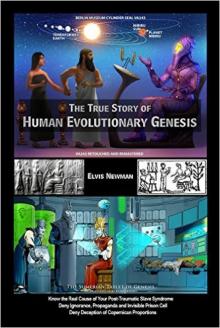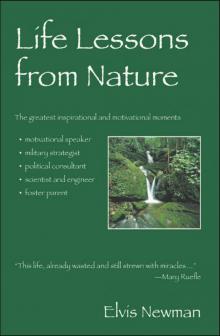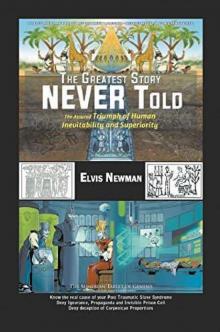- Home
- Elvis Newman
True Story of Human Evolutionary Genesis Page 2
True Story of Human Evolutionary Genesis Read online
Page 2
Chapter One
The Debate for the Anunnaki and Ape Hybrids
B.C. 450,100.
In the Court of King Anu, Planet Nibiru, the important issue of primitive workers on Colony Earth was raised. All the elders, wise men, savants, gifted, prodigies, clairvoyants, famous, scientists, leaders, commanders, explorers, entrepreneurs, and people’s rep- resentatives were gathered in the assembly for a long and bitter re- lated discussion on morality, labor laws, enslavement mandates, interplanetary journey stipulations, and Planet Nibiru’s atmospheric conditions.
The central issue was: Should primitive workers be genetically engineered and created to solve the astronauts’ labor dispute and possible mutiny?
Major proponents were led by Enki, second commander of Ter- ran Operations.
“Make Homo erectus more intelligent by changing them into Homo sapiens. Our commands he will then understand. Our tools he will then handle. He shall perform the toil in the excavations. We will have no more labor disputes coming from our astronauts work- ing as gold miners.”
“It is not a new creature created by us. The plan is to give this ape creature that we found on Earth more ability, make them more to our likeness. Only a tiny segment of our DNA is all that is needed.”
Opponents were led by Enlil, supreme commander of Terran
Operations.
“Technological improvements in production methods, toolmak-
ing, and machinery would make a better choice. Anunnaki should
not play God by creating slave beings!”
3
Elvis Newman
“Creation is the power held by the Father of All Beginnings, not Anunnaki. We are sent to Earth to obtain gold to repair Nibiru’s dwindling atmosphere, not to replace the Father of All Beginnings.” There was no verdict after many days of intense debate and de- liberation. On the seventh day, the Supreme Council of King Anu
reconvened for the seventh time.
“Can we get the finest gold dusts in the galaxy in any other way?
Our Planet Nibiru is dying. The survival of the glorious Anunnaki
civilization hangs in the balance. We must get gold to repair
Nibiru’s broken ozone. We must get the finest gold dusts in the
galaxy at all costs.”
“Let us forget about interplanetary travel rules and save Nibiru.
If there is no Planet Nibiru, there will be no Anunnaki civilization.
If there is no Anunnaki civilization, there is no need for interplane-
tary travel rules.”
“Let us save Nibiru by the creation of slave workers through
high tech genetic engineering!”
4
Chapter Two
The Story of the Garden of Eden, Prehistoric Iraq
B.C. 450,100.
Enki, second commander of Terran Operations, was rocketed to Earth with fifty medics, six hundred miners, three hundred astro- nauts, and a hundred administrators.
So the Anunnaki came to the earth around four hundred and fifty thousand years ago to mine gold in what is now Africa. The main mining center was in today’s Zimbabwe, an area the Sumeri- ans called AB.ZU (deep deposit). The gold mined by the Anunnaki was shipped back to their home planet from bases in the Middle East.
At first, the gold mining was done by the intelligent and physi- cally robust Anunnaki astronauts and miners. These men were of the respectable elite back home. However, they were made to toil and work as miners on Earth in order to save Nibiru. Eventually, there were riots and rebellions, and the Anunnaki royal leadership decided to create a new slave race to do the work.
Made on Earth
5
Chapter Three
Terran Wildlife Natural Reserve and Research Center
Garden of Edin, Prehistoric Iraq
Enki and his son Ningizidda led a team of biologists to set up a lab for Earth animal studies. Special interest was given especially to Homo erectus, a species Enki identified as due to evolve in a few million years into Homo sapiens, the species like the Nibirans.
The apes kept at the reserve were studied carefully by the Anun- naki. Found in the African forests, the apes walked erect on two legs. Their forelegs they used as arms. They lived among the animals of the steppe. They ate plants with their mouths. They drrank water from lakes and ditches. It was a thrill to see them alive! They were kept in strong cages. At the sight of visitors, they jumped up with fists beating on the cage bars, grunting and snorting and speaking no words. Just like the Anunnaki, they had males and females!
The study of Homo erectus revealed that just like the chim- panzees, gorillas, and orangutans, they had twenty-four pairs of chromosomes. Ningishzidda, president of the Biogenetics Council, explained to Ninmah, the chief medical officer, how the second and third chromosomes of Homo erectus could be fused together to give rise to the intelligent new ape. This fusion could only be accom- plished in the Terran genetic splicing laboratory through manipu- lation of the egg. No disease or natural genetic condition had ever caused a species to alter its chromosomal structure!
(*All members of Hominidae except humans have twenty-four pairs of chromosomes. Humans have only twenty-three pairs of chromosomes. Human chromosome 2 is widely accepted to be a re- sult of an end-to-end fusion of two ancestral chromosomes. Wikipedia.)
6
The True Story of Human Evolutionary Genesis
To the astonished Ninmah, Ningishzidda continued, “There are things that we can do now that surpass your wildest dreams. We can jump the gun on the new ape’s progress, and make it into Homo sapiens through infusion of some Anunnaki gene segments!”
“Oh, Homo erectus! They are too odd, too monstrous, and too barbaric!”
“That is why you are needed for their perfection into Homo sapiens!”
Enki, second commander of Terran Operations, said to Ninmah and Ningishzidda, “Gather your teams and start working!”
Footnote
In Inside the Human Genome: A Case for Non-Intelligent Design by John C. Avise, the author argues that from the perspectives of bio- chemistry and molecular genetics there are numerous flaws that exist in the biological world. There is overwhelming scientific evi- dence for genomic imperfection, imperfections that extend deep down to the level of our genes, and evidence also exists that there are many gross deficiencies in human DNA, ranging from muta- tional defects to built-in design faults.
The oversimplified and often touted claim that the DNA of chimpanzees (Pan troglodytes) and humans (Homo sapiens) are about ninety-eight percent similar, a claim made by Oxford profes- sor Richard Dawkins and other evolution proponents, can be re- futed by genomic scientists. Dr. Jeffrey Tomkins explored how chimps became our closest ancestor and the DNA based early evi- dence that started this misconception in his book, More Than a Mon- key.
7
Chapter Four
A.C. T. G. -- Adenine, Cytosine, Thymine, and Guanine
Anunnaki Center for Terran Genetics, Garden of Edin, Prehistoric Iraq
Anunnaki Human Hybrid Research Commission
We have the strongest hybrids management systems in the solar system. Thanks to our xenobiologists’ hard work, we now have made the most recent accomplishment in hybrid gene and DNA for- mation. Human genetics is an important milestone in our efforts to secure profitable and healthy primitive workers. To make sure that our research and science remain topnotch, new legislation and King Anu’s appropriations for science and management are critical to maintain this momentum.
Because what we have done so far is historic, we shall commem- orate our achievements by encoding the intelligent ape’s genetic in- formation as a sequence of nucleotides: adenine, thymine, cytosine, and guanine, with the acronym for our organization A.C.T.G.
Footnote
A group of researchers working at the Human Genome Project indicate that they made an astonishing scientific discovery: They be- lieve so-called 97 percent non
coding sequences in human DNA is no less than genetic code of extraterrestrial life forms, says Prof. Sam Chang, the group leader. The overwhelming majority of human DNA is “off-world” in origin. The apparent “extraterrestrial junk genes” merely “enjoy the ride” with hardworking active genes, passed from generation to generation.
8
The True Story of Human Evolutionary Genesis
After comprehensive analysis with the assistance of other scien- tists, computer programmers, mathematicians, and other learned scholars, Professor Chang had wondered if the apparently “junk human DNA” was created by some kind of “extraterrestrial pro- grammer.” The alien chunks within human DNA, Professor Chang further observes, “have its own veins, arteries, and its own immune system that vigorously resists all our anticancer drugs.”
Professor Chang further stipulates that “Our hypothesis is that a higher extraterrestrial life form was engaged in creating new life and planting it on various planets. Earth is just one of them. Per- haps, after programming, our creators grow us the same way we grow bacteria in Petri dishes. We can’t know their motives— whether it was a scientific experiment, or a way of preparing new planets for colonization, or is it long time ongoing business of seedling life in the universe.”
Professor Chang and his research colleagues show that apparent “extraterrestrial programming” gaps in DNA sequencing precipi- tated by a hypothesized rush to create human life on Earth pre- sented humankind with illogical growth of mass of cells we know as cancer.” Very likely in an apparent rush, the “extraterrestrial pro- grammers” may have cut down drastically on big code and deliv- ered basic program intended for Earth.”
9
Elvis Newman
Professor Chang further indicates that “What we see in our DNA is a program consisting of two versions—a big code and basic code.” Mr. Chang then affirms that the “First fact is the complete
‘program’ was positively not written on Earth; that is now a verified fact. The second fact is that genes by themselves are not enough to explain evolution; there must be something more in ‘the game.’”
“Sooner or later,” Professor Chang says, “we have to come to grips with the unbelievable notion that every life on Earth carries genetic code for his extraterrestrial cousin and that evolution is not what we think it is.”
10
Chapter Five
Natural Cycle in Vitro Fertilization (IVF)
Series and series of genetic experiments were carried out fervently. And their results and products were carefully documented.
Admixture of essences was prepared with mitochondria ex- tracts, Anunnaki spliced genes segments, and ova of female Homo erectus impregnated with Anunnaki sperm.
Fertilized ova was inserted back to the womb of the ape Homo erectus.
A birth was expected. No birth was forthcoming.
In desperation, Ninmah made a dissection and pulled out the
baby with tongs. It was a living being.
11
Elvis Newman
Ningishzidda cried out, “We are successful!” Ninmah was not filled with joy.
The newborn was shaggy with hair all over. His foreparts re- sembled the Homo erectus. His hind parts resembled the Anunnaki.
The newborn was breastfed by the mother Homo erectus. The newborn was growing fast. A day in the Anunnaki planet is about a month in Africa.
The child grew tall, not looking like the Anunnaki. His hands could not hold tools.
He could only make grunting sounds instead of speech.
Intravaginal culture (IVC)
Once again, the experiment was done after changing the admix- ture. Nimah carefully considered and examined the Anunnaki essences. One bit she took from one. One bit she took from another.
In the Nibiru made test tube, the ova of an Earth female was in- seminated. The tube was then hermetically closed and was placed in the maternal vagina and held by a diaphragm for incubation for forty-four to fifty hours.
After this time, the content of the tube was examined, and em- bryos were transferred to the uterus.
There was conception. There was birth giving. This one looked more like the Anunnaki. The baby was breastfed by his ape mother and nurtured.
He looked appealing, hands fit to hold a tool. However, he was lacking in senses. He could not hear and had bad eyesight.
The persistent and patient Ninmah repeated the experiments with varying compositions of the admixtures thousands of times.
12
Chapter Six
Nimah’s Progress Entry
“Hello there, I am Nimah, the chief medical officer for the Terran Genome Project, and I am here to present to you the creatures that will change the world as we know it—the humans, our slave race.
“This creature can manipulate tools and create different things. For example, give it an object and ask it to turn it into something. It will comply. Most importantly, if you ask it, it will work as a miner in our excavations. This creature also holds many wonderful sur- prises as promised. My team and I will keep trying and trying until the perfect creature as envisioned by our leaders is created.”
Hundreds of babies were created each year and their conditions compared. The dead babies were then dissected and their organs and parts comparatively analyzed.
The best case of each year was selected for report. Even then, the best cases were often fraught with defects.
Enki, Ninmah, and Ningishzidda mapped chromosomes, genes, and genomes. They fertilized ova in test-tube flasks with sperm soaked in Nibiran blood serum and mineral nutrients. They exper- imented with cloning, cell fusion, and recombinant technology— cutting DNA strands with enzymes and targeted viruses. They absorbed sperm in genetic material to be used for fertilization. They spliced DNA patches of other species to create, at first, hybrids, which were unable to reproduce. Then Ningishzidda isolated the XX and XY chromosomes, which allowed the creation of fertile Nibi- ran/erectus mine slaves [ZS, 1990, Genesis: 158 - 182, 202].
Progress entry 30091 B.C. 450,000: Using ultrasound fetal scan- ning, we found this new baby to have paralyzed feet.
13
Elvis Newman
Progress entry 48762 B.C. 449,999: The new being had semen dripping.
Progress entry 58973 B.C. 449,998: This new one had progeria, which caused trembling hands.
Progress entry 67554 B.C. 449,997: Amniocentesis indicated this new one had a malfunctioning liver.
Progress entry 76545 B.C. 449,996: Upon birth, we found this new one had hands too short to reach the mouth.
Progress entry 87656 B.C. 449,995: Through fetal electrocardio- gram (ECG), we could tell this new one had alveoli atrophy in the lungs, and he could not breathe enough air.
Enki was greatly disappointed.
“We just cannot create a primitive worker!”
Nimah said to Ningishzidda and Enki, “By trial and error, I am
realizing what works. We must persist.”

 True Story of Human Evolutionary Genesis
True Story of Human Evolutionary Genesis Life Lessons from Nature
Life Lessons from Nature The Greatest Story NEVER Told
The Greatest Story NEVER Told